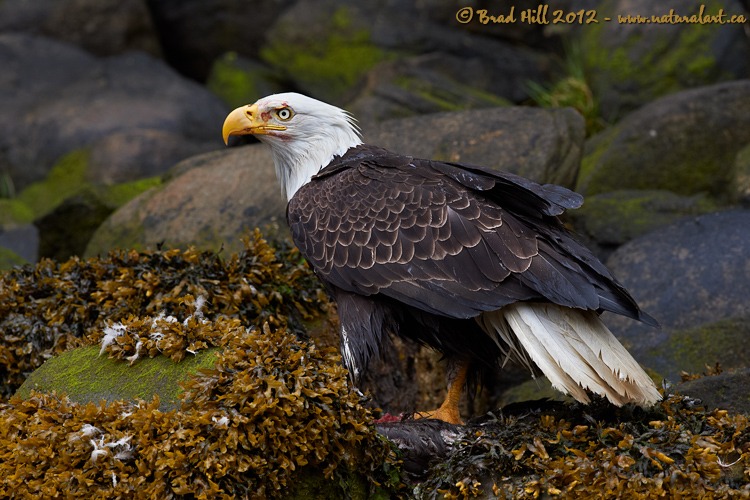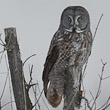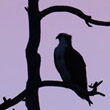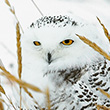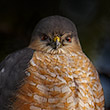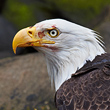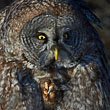Availability: Undetermined - Enquiries?
In the Field
Dead Goose - But Happy Eagle! Khutzeymateen Grizzly Sanctuary, Great Bear Rainforest, BC, Canada. May 30, 2012.
Although British Columbia's Khutzeymateen Inlet is best known for its grizzly bears (for good reason), the inlet has a lot of other interesting wildlife. That list includes wolves, harbor seals, otters, mink, a plethora of songbirds, waterfowl, and of course, some pretty spectacular birds of prey - such as Sharp-shinned and Coopers Hawks and Harriers. And, there's always a Bald Eagle or two hanging around!
We noticed this Bald Eagle on the shoreline near where our 71' sailboat (our "floating basecamp") was anchored. Other eagles were in the area and were swooping down to harrass this one, which we thought likely signified that THIS eagle was "sitting" on something worthwhile. Turns out we were right - this fellow was on a freshly killed Canada Goose. A tiny bit of its flesh and some of its downy feathers are visible in this shot.
Capturing this image involved climbing over a few logistic and technical hurdles. On the logistic end the biggest constraint was finding an angle where foreground rocks didn't fully obscure the eagle's prey or overlap the subject itself. We were in a Zodiac that was being pushed by tidal currents, so we had to position the boat "upcurrent" from the eagle and drift by. Fortunately the eagle was so focused on its food it allowed close approach, but there were only a few gaps in the rocks the allowed a clear view of the eagle (except for its left foot!) and a partial view of the prey. Bottom line was you had to anticipate exactly when the gap open up and shoot quickly when it did.
On the technical end there were primarily two hurdles to clear. First was getting the exposure "right". In this case the biggest problem exposure-wise was choosing settings that didn't over-expose the white regions (head and tail) - blowing those out (and losing critical light-on-light detail) would totally ruin the image. I use Nikon's matrix (multi-segment) metering about 99% of the time - it's very good, but not foolproof. When using it you have to be very careful of blowing out highlight details, especially if the white regions occupy on a fairly small amount of the total frame. From experience I knew I had to back off (negatively compensate) the "suggested" meter reading pretty significantly to save the highlights - I chose a -1.67 stop compensation and just saved the brightest highlights.
The second technical issue to overcome was related to depth of field (or DoF). In my opinion it was critical to keep virtually all the foreground (and especially those downy feathers from the goose) in sharp focus in order for the image to "work". The tendency when using super-telephotos is to "open them up" (choose a large aperture). This is done for a number of reasons - to get the shutter speed high enough (without a crazy ISO) to avoid camera shake, to isolate your subject from the background with a shallow DoF, etc. This "open it up" tendency is even more pronounced when hand-holding big lenses, which is what I was doing here. I had to counter this natural tendency and stop the aperture down - this image (one of my favourite from the encounter) was shot at f9, which isn't something I do a lot when hand-holding my 400m f2.8 lens!
NOTE: This image was captured during one of my 2012 Khutzeymateen photo tours within the Great Bear Rainforest of British Columbia. I offer both instructional photo tours and "photo op only" photo tours into the Great Bear Rainforest each spring and autumn. If you're interested in participating in one of these trips, just check out the Photo Tours page of this website!
Behind the Camera
Dead Goose - But Happy Eagle! Khutzeymateen Grizzly Sanctuary, Great Bear Rainforest, BC, Canada. May 30, 2012.
Digital Capture; RAW 14-bit format; ISO 640.
Nikon D4 paired with Nikkor 400mm f2.8 VRII lens. Hand-held from floating Zodiac. VR on and set to "normal" mode.
1/400s @ f9; -1.67 stop compensation from matrix-metered exposure setting. Auto ISO engaged with Auto shutter speed enabled (shutter speed keyed to focal length of lens with no compensation).
At the Computer
Dead Goose - But Happy Eagle! Khutzeymateen Grizzly Sanctuary, Great Bear Rainforest, BC, Canada. May 30, 2012.
RAW Conversion to 16-bit TIFF, including first-pass/capture sharpening using Capture One Pro. Three raw variants (processed from raw) differing by a total of 1.2 stops in exposure - from -0.33 stops from original exposure to 0.88 stops from original exposure.
Further digital corrections on resulting 16-bit TIFF files using Adobe's Photoshop CS6 and Light Craft's Lightzone. Photoshop adjustments including compositing the raw conversion variants (layering and masking), selective tone curve adjustments (adjustment layer), selective colour saturation and desaturation (more adjustments layers!), and selective sharpening for web output. Final tone tweaking performed using tonemapper/re-light tool in Lightzone.
Conservation
Dead Goose - But Happy Eagle! Khutzeymateen Grizzly Sanctuary, Great Bear Rainforest, BC, Canada. May 30, 2012.
Ten percent of the revenue generated by this image will be donated to Raincoast.
Species Status in Canada*: This species is not designated as at risk. The Bald Eagle was listed as "Endangered" in the contiguous US states from 1967 to 1995. In 1995 it was downlisted to "Threatened". On June 28, 2007 Bald Eagles were removed from the list of endangered and threatened species - a true American conservation success story.
The Bald Eagle (Haliaeetus leucocephalus) is a very large bird of prey with broad wings. Adults possess characteristic white ("bald") heads. It takes Bald Eagles a full five years to attain their characteristic adult plumage (including their nearly pure white head and tail). In the years prior to the development of their adult plumage they are easy to confuse with Golden Eagles. Being very broad-winged Bald Eagles are able to use an energy-efficient flapping-soaring style of flight. While many people like to think of the Bald Eagle as a fierce hunter, in reality they hunt only as a last resort. More commonly they scavenge for their prey. Additionally, they often klepto-parasitize other weaker species such as Osprey, commonly stealing the other species hard-earned prey items. The Bald Eagle is, of course, the national emblem of the United States (Benjamin Franklin argued against this - his preference was for the Wild Turkey).
This Bald Eagle was photographed in the heart of the Great Bear Rainforest. While Bald Eagles are currently not under the threat of extinction, they do, of course, require suitable breeding habitat to continue to thrive. The Raincoast Conservation Society (and Foundation) is an effective and efficient organization that has been fighting for protection of this unique habitat. If you are looking for a meaningful way to contribute to the conservation of this amazing ecosystem, Raincoast will provide maximal "bang" for your conservation dollars.
*as determined by COSEWIC: The Committee on the Status of Endangered Wildlife in Canada













